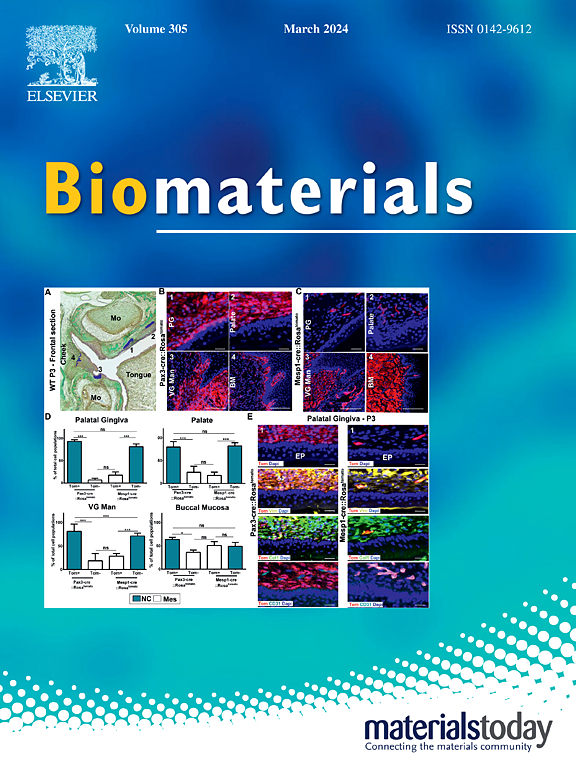电子受体基元操纵的NIR-II AIE光敏剂通过多模态图像引导的纯I型光动力和光热疗法协同诱导肿瘤热亡
IF 12.9
1区 医学
Q1 ENGINEERING, BIOMEDICAL
引用次数: 0
摘要
焦亡是程序性细胞死亡的一种形式,以其诱导免疫原性细胞死亡(ICD)的强大能力而闻名,它触发损伤相关分子模式(DAMPs)的释放,从而放大癌症免疫治疗。近年来,光控焦亡已成为光动力治疗(PDT)中一种很有前途的策略。然而,大多数现有的光敏剂都依赖于I型和II型活性氧(ROS)的产生,这不仅导致在缺氧肿瘤环境中效果不佳,而且限制了治疗的深度和选择性。在这项研究中,我们报道了一种溶酶体靶向聚集诱导发射(AIE)光敏剂PTQ-TPA3,通过分子进化策略通过受体单元环融合和转子集成进行工程设计。PTQ-TPA3独特地实现了高效的纯I型ROS生成,同时具有近红外ii (NIR-II)荧光发射和光热转换特性。在包括光声、NIR-II荧光和光热成像在内的多模态成像模式的指导下,PTQ-TPA3纳米颗粒能够协同光动力和光热治疗,从而驱动强大的icd介导的光疗。此外,PTQ-TPA3在低氧肿瘤环境中通过产生纯I型ROS,同时利用其光热效应诱导焦亡,显示出卓越的功效。这种双重机制有效地根除癌细胞并刺激全身抗肿瘤免疫,为创新的治疗策略铺平了道路。本文章由计算机程序翻译,如有差异,请以英文原文为准。
Electron acceptor motif-manipulated NIR-II AIE photosensitizers synergically induce tumor pyroptosis through multimodal image-guided pure type I photodynamic and photothermal therapy
Pyroptosis, a form of programmed cell death, is known for its strong capacity to induce immunogenic cell death (ICD), triggering the release of damage-associated molecular patterns (DAMPs) that amplify cancer immunotherapy. Recently, photocontrolled pyroptosis has emerged as a promising strategy within photodynamic therapy (PDT). Nonetheless, most existing photosensitizers exhibit a reliance on both type I and type II reactive oxygen species (ROS) generation, which not only leads to suboptimal efficacy in hypoxic tumor environments but also limits therapeutic depth and selectivity. In this study, we report a lysosome-targeted aggregation-induced emission (AIE) photosensitizer, PTQ-TPA3, engineered through receptor unit loop fusion and rotor integration via molecular evolution strategies. PTQ-TPA3 uniquely achieves highly efficient pure type I ROS generation, alongside near-infrared-II (NIR-II) fluorescence emission and photothermal conversion properties. Under the guidance of multimodal imaging modalities, including photoacoustic, NIR-II fluorescence, and photothermal imaging, PTQ-TPA3 nanoparticles enable synergistic photodynamic and photothermal therapy to drive robust ICD-mediated phototherapy. Furthermore, PTQ-TPA3 demonstrates exceptional efficacy in hypoxic tumor environments by producing pure type I ROS while leveraging its photothermal effect to induce pyroptosis. This dual mechanism effectively eradicates cancer cells and stimulates systemic antitumor immunity, paving the way for innovative therapeutic strategies.
求助全文
通过发布文献求助,成功后即可免费获取论文全文。
去求助
来源期刊

Biomaterials
工程技术-材料科学:生物材料
CiteScore
26.00
自引率
2.90%
发文量
565
审稿时长
46 days
期刊介绍:
Biomaterials is an international journal covering the science and clinical application of biomaterials. A biomaterial is now defined as a substance that has been engineered to take a form which, alone or as part of a complex system, is used to direct, by control of interactions with components of living systems, the course of any therapeutic or diagnostic procedure. It is the aim of the journal to provide a peer-reviewed forum for the publication of original papers and authoritative review and opinion papers dealing with the most important issues facing the use of biomaterials in clinical practice. The scope of the journal covers the wide range of physical, biological and chemical sciences that underpin the design of biomaterials and the clinical disciplines in which they are used. These sciences include polymer synthesis and characterization, drug and gene vector design, the biology of the host response, immunology and toxicology and self assembly at the nanoscale. Clinical applications include the therapies of medical technology and regenerative medicine in all clinical disciplines, and diagnostic systems that reply on innovative contrast and sensing agents. The journal is relevant to areas such as cancer diagnosis and therapy, implantable devices, drug delivery systems, gene vectors, bionanotechnology and tissue engineering.
 求助内容:
求助内容: 应助结果提醒方式:
应助结果提醒方式:


